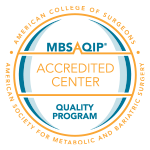Bariatric Surgery

If you are significantly overweight or obese and unable to keep weight off despite multiple attempts at diet and exercise, bariatric surgery may be an option. Englewood Health’s experts use the latest options and techniques to help people lose weight and keep it off. Weight loss surgery is not just about your looks — it’s also about your health. Surgery can help prevent or reduce many of the serious health problems caused by obesity and metabolic syndrome (a group of conditions that includes diabetes, high blood pressure and high cholesterol).
Our Expertise
More than 400 patients a year choose Englewood Health for weight loss surgery. We offer:
- Board-certified compassionate surgeons who perform minimally invasive weight loss surgery whenever possible
- Access to a program coordinator, dietitian, and other healthcare professionals to help with your care, both before and after surgery
- Comprehensive education and support so you are fully prepared for your surgery and recovery
- Medical weight management for those who don’t qualify for surgery or do not want to have surgery
- Accreditation by the Metabolic and Bariatric Surgery Accreditation and Quality Improvement Program, awarded by the American College of Surgeons to programs that demonstrate high standards of care
Your Next Steps
1. See if you qualify for weight loss surgery.
To qualify for weight loss surgery, you must:
- Be 100 pounds or more above ideal body weight, or
- Have a body mass index (BMI) of 40 or greater, or
- Have a BMI of 35 or greater with one or more obesity-related health condition. Calculate your BMI now.
Other qualifying factors may include:
- History of documented, failed weight loss attempts
- Lifelong commitment to lifestyle changes in diet, exercise, and medical guidelines
- Psychological evaluation
Together, you and a surgeon will determine if surgery is right for you and which type of procedure is your best option. You also will meet with a dietitian, psychologist, and other support staff leading up to surgery. Each team member will help you prepare for the exciting changes, as well as challenges, ahead.
2. Watch our online patient education videos.
If you are thinking about weight loss surgery, watch our patient education videos online. The videos provide information on the types of procedures and the lifestyle changes that are needed for successful weight loss surgery, including diet, exercise, and relationship changes.
3. Make an appointment with one of our bariatric surgeons.
Use our doctor search to find a bariatric surgeon. At your first appointment, the surgeon will complete a medical history and, if you are eligible, will recommend the procedure that is best for you. If you want to proceed with surgery, you’ll be scheduled for further testing including blood work, X-rays, and EKG, as well as nutritional and psychological evaluations. During this preparation process, your surgery date is scheduled.

